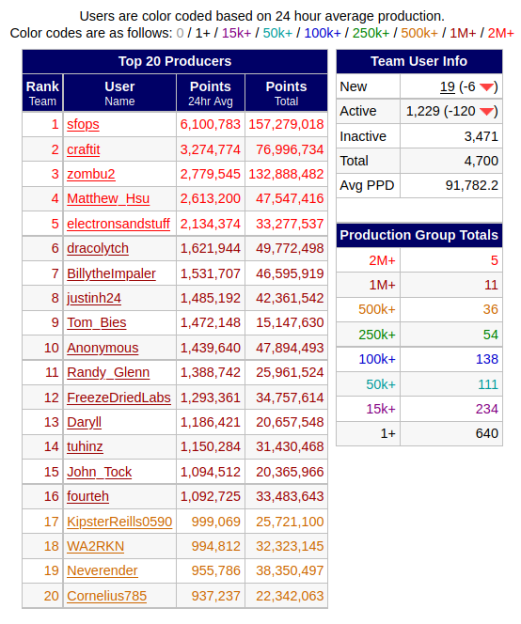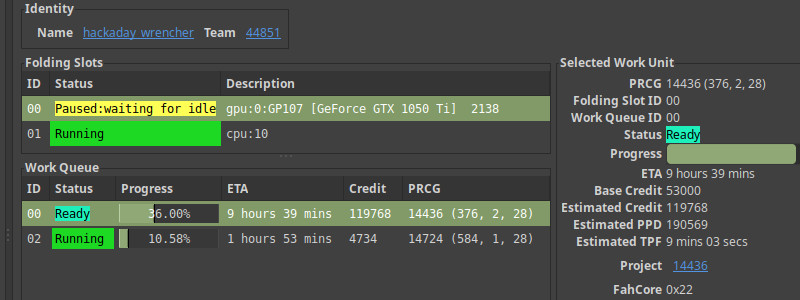The Hackaday community has answered the call and put their computers put to work folding proteins found in the coronavirus. Team_Hack-a-Day ranks #44 in the world so far this month, and I’ve seen us rank as high as #19 on 24-hour leaderboards.
Want to join the fight? Donate some of those computing cycles you’re not using to battling SARS‑CoV‑2. You’re probably not an epidemiologist or a vaccine researcher, but you can make their jobs easier by providing them with the data they need through the Folding@home Project.
As Dan Maloney explained in his excellent article on protein folding, understanding the incredibly complex folding behavior of the proteins in the virus will be key to finding treatments and possibly a vaccine. Folding@home connects countless computers via the internet and is now the largest supercomputer in the world, consisting of over 3.5 million CPUs and over half a million GPUs. The resulting data is freely available to researchers.
Let’s take a look at how easy it is to get up and running, how a GPU can supercharge a setup, and dip into the stats for Team_Hack-a-Day’s effort.
Setup is Simple
Your computer can be up and folding in ten minutes:
- Installation Guides
- There are also alternate download locations available
- Choose any alias you’d like to use for publicly displayed leaderboard
- Use team number 44851
- Optional: set up your own passkey
That’s it! But you’ll get more bang for your processing buck if you have a powerful video card in the mix. I finally got my own GPU running on the system and it quintupled my impact.
A Somewhat Dubious Guide to Linux GPU Setup
I have an Nvidia GeForce GTX 1050 Ti video card and I don’t game on this machine (unless you count Minecraft) so I might as well put it to good use folding proteins! Unfortunately, I couldn’t find a guide and the setup took me a while to work out. Hopefully by documenting my experience I can help others get their systems up and running a bit faster.

Folding@home can use GPUs via open OpenCL or CUDA (Nvidia cards only). I didn’t know exactly which packages I needed so I just installed them all. That’s why I call this a dubious install guide, you might not need all of these packages — for me, this install took about 1.5 GB of additional disk space. One note, I already had nvidia-driver-435 installed and used this command for the rest:
sudo apt install \
ocl-icd-libopencl1 \
ocl-icd-opencl-dev \
ocl-icd-dev \
nvidia-opencl-dev \
nvidia-cuda-toolkit
I restarted the Folding@home client: sudo /etc/init.d/FAHClient restart. However, this didn’t enable the ability to add a GPU in the Configuration–>Slots menu. I first needed to edit the configuration file itself and change the “gpu” value to true:
<!-- Folding Slot Configuration --> <gpu v='true'/> <!-- If true, attempt to autoconfigure GPUs -->
I once again restarted the client, then enabled the GPU using the add button found in the Configure–>Slots window of the FAHControl program. Alternatively you should be able to edit the config file directly and restart the client for it to take effect:
<!-- Folding Slots -->
<slot id='0' type='GPU'>
<idle v='true'/>
</slot>
<slot id='1' type='CPU'/>
Note that there’s a bit of extra magic in this configuration. After waiting about 90 minutes my GPU was assigned its first work unit (WU) and began folding, at which point my computer became totally unusable. Luckily the idle setting is how you workaround this — it instructs the client to pause folding whenever the computer is in use. You can configure it per slot, so here I have my CPU folding all the time and my GPU only folds when I’m not using my computer.
You can set the idle behavior by right-clicking the slot in the FAHControl GUI and choosing “on idle”. My CPU can fold for about 60,000 points a day, my GPU can fold for over 200,000 points per day. Figuring out this setup greatly increases my ability to contribute WUs to the effort!
 Top of the Team_Hack-a-Day Leaderboard
Top of the Team_Hack-a-Day Leaderboard
Check out the people folding and putting up huge numbers for Team_Hack-a-Day. At the very top is [sfops], the operations team at Hackaday’s parent company Supplyframe. They’ve directed their idle server resources to folding, and have been in the number one slot for at least six weeks now. [zombu2] has been in the top five for that period as well!
We’d love to see others commit big iron to the cause, and can’t wait to hear your story about that in the comments below. But as I mentioned in the GPU setup section, my daily driver is capable of putting up a quarter million points per day. What we really need are strength in numbers, so please consider adding your own computer to the effort. Thank you to everyone who is pitching in!
Joins us and let your computer mine for something that really matters: massive data sets for crucial medical research. Go Team_Hack-a-Day!
















How hard would it be to create an xbox/playstation app to help with this?
Or an iPad version? I know the processing capacity would be minimal, but hey a protein fold is a protein fold.
I think that most of flagship models of mobile devices could join. They could work in the night while being charged. I would join if my phone was compatible with that.
I heard that could overheat mobile devices but who says thay can’t work at 75% capacity?
That is an interesting idea, I wonder if, say, a million phones adds up to much power when compared to GPU time already regularly donated? Not that one could (iirc) port it to the devices without folding@home helping, as it’s closed source. Happy to be wrong though.
Someone actually have to code it up to take advantage of the CPU/GPU in those machine. The additional difficult is that the code have to be *signed* by MS or Sony as the DRM in game console. MS & Sony make money on licensing, so they don’t allow people to run arbitrary codes
The PS3 had it as part of “Home” if I recall correctly called Folding@Home.
It was removed years ago.
Will any of the COVID patients pay for electricity I wasted doing reseach? Remember there’s no such thing as free lunch.
Will any of the people fueling their cars with gas/petrol pay for the damage to the atmosphere? When the answer is yes then we can talk.
That’s called fuel duty + vehicle excise duty or such
And yet it doesn’t pay to restore the atmosphere.
The tax is paid it’s up to the collector to throw the money appropriately
Yeah well, probably not 2 cents in every dollar put on to fix the roads will fix the roads either, so whack another dollar on for the environment and that’ll get some glossy pamphlets printed full of empty promises.
Will any of the people using laptops/phones/tablets to make petty comments on the internet pay for the damage to the atmosphere and stripmining for components?
When the answer is yes, we can talk about my car.
Strip mining is indeed another issue that needs to be addressed. If we taxed corporations for the damage they do (so it can be undone by another corp) then we could have a balanced ecosystem and economy.
No ones forcing you to help. I bet your opinion would change if someone you know got COVID-19.
If you got cancer and a cure was discovered, you would pay the researchers and volunteers for their “wasted” time?
Also electricity is dirt cheap asshole
“Also electricity is dirt cheap asshole”
*looks at latest electric bill*
Knowledge is power, so doing research is net positive
Humans are a naturally collaborating species. Look no further for examples, people here in the HAD community teach eachother without expecting money in return. Libertarian capitalism seems to work very well for people with a swimming pool in the backyard, but there IS free lunch, now and always.
You can get Curecoin/Foldingcoin. They’re cryptocurrencies that are mined using Folding@Home.
No one will. But the good news is that none of the FAH participants will charge you in case you get sick.
I’m still participating, but I wonder : what happens when a good protein is found ? Then a large farmaceutical company will run off with the results and make the world pay enormous prices, not to mention “America First”. So, explain to me again why I am participating ?
Because not having a solution is far worse.
my point is that calculating the solution will not help you at all. In my view not being able to obtain an existing solution is far worse than having no solution at all. I’m out.
as a ps : If the US finds the cure, it will be used as a geopolitical weapon, I’m sure. And I strongly suspect the other powers will do the same when they find it first.
So we’ll live in isolation forever?
This may fix things, but sitting around doing nothing will definitely mean isolation for everyone forever.
People do things all the time that gives no immediate return. This is no different.
You are barking at the wrong tree. Finding the proteins is NOT making a vaccine, it’s just the starting point. That information will be published.
F@H publishes all their results freely if memory serves.
So, company A will develop it and start price gouging, then company B sees that, uses the same F@H data and undercuts company A. Rinse and Repeat until a price war puts it down to a reasonable price.
Ever heard of price fixing? Yes, the results might be open for the world to see, but pharmaceutical corporations have the power to dictate pricing (and they sure do) based on propietary mfg.technology, R&D and so on. And that’s before we even consider patent wars.
Or they will rush to the patent office.
Any solution will take years to come to market. We will be way past the need for this by then. Don’t waste your electricity and money.
Exactly. What we need now are blood plasma donations from people who already had COVID-19, this can save the life of patients with immune deficiencies.
Yeah. Folding at home hasn’t produced any actionable data leading to any real-world treatments in over ten years of operation afaik. The crank in me wonders if it’s not just mining monero on everyone’s machine.
Folding is kind of like theoretical physic. It helps to understand the fundamentals of the virus and how it interacts, but unlikely to produce anything tangible. The cure and vaccine side is kind of like engineering and it tries to make a product and how to scale them.
There are more useful progress outside of simulations:
https://www.scmp.com/news/china/science/article/3083199/synthetic-coronavirus-created-brewers-yeast-comes-research
>Scientists have created a fully synthesised strain of the coronavirus with brewer’s yeast, according to a new study from Europe.
>This development would help “provide an infectious virus to health authorities and diagnostic laboratories without the need of having access to clinical samples”, said the researchers led by Joerg Jores and Volker Thiel from the University of Bern in Switzerland, in a paper published in Nature on Monday.
>In theory, biological engineers can recreate a life form if they know its full genome sequence. In real life though, they can only synthesise some simple organisms with short genome sequences.
>In the planning stage, the researchers divided the coronavirus genes into 14 fragments; they then bought most of these fragments from a biology company. They put the fragmented genes into the yeast, which automatically combined them piece by piece, from head to tail, until a complete genome was formed.
>The recombined genome could not infect cells as a virus does. But using electricity, the scientists injected the man-made genome into a cell to mimic the viral infection. Once in the cell, the viral genome started replicating and mass-producing the fully formed virus with genetic material wrapped in spiky protein shells.
>With the yeast-based technology, scientists could create an active strain in a week after obtaining the sequencing data, according to the researchers.
>These man-made strains would “functionally characterise Sars-CoV-2 evolution in real time”, they said.
>Zhang said the man-made strains would help the fight against the pandemic. Although computers could predict the impact of a changing gene on the virus’ form and functions, the models could sometimes make a mistake.
This last part is why you want to tinker with something at some point instead of running simulations. This process is also the way of scaling up manufacturing “samples” of virus RNA sequence to make vaccine.
A pox on you naysayers. I figured adding my spare cycles could be my contribution to the fight against the epidemic. And I also recruited two other friends too. I’ve had my laptop running full tilt for the past 6 weeks. I was actually encouraged enough to go out and invest in a pretty good NVIDIA card and a new computer to host it last week. I’m now adding over a million points worth of folding to the team every day! Do I want money for the electricity? It would be nice… but no, I don’t. A tax deduction would also be appreciated, but I won’t be waiting for it. I’m happy enough investing into being part of the solution, and not just sitting on the sidelines criticizing those that do actually try to help.
A million points a day? That’s crazy.
I guess I’m running pretty old hardware, and no GPU fast enough to complete a work unit in a day. I’ve done just over 2 million points (on a different team) in the past eight weeks, total. Across 5 different machines (none of them with a GPU. :( ).
Yeah, isn’t it! I bought an Nvidia RTX2060, which according to the Folding forums gives you the best bang for the buck and for the kilowatt. I only started Folding at the end of March, when I saw the first post on Hack-a-day post, with my 4 core laptop earning me about 15K points per day. After a month of that, I bought the new desktop for the Nvidia card, and it earned me an additional 50K PPD. Then I configed that GPU and it is giving me another 1M PPD. Now I’m cooking!
No Source – No Go!
Copyright is slowing down research once again:
https://foldingathome.org/support/faq/opensource/
“We have not outsourced the client for several reasons, relating to client reliability and other issues.”
I won’t install your blob.
My machines are already sitting idle about 50% of the time or more. I’m about this close to pulling the plug. I’m not leaving computers powered on for them to sit idle. I tried bearing with the overload, but they don’t seem to be saying much about it now. Yet, I continually get could not get WU. Don’t ask for more people to join until there is work to be done
That’s strange, my machine is pretty much constantly folding. Maybe try remove your slots and add them back again? Restart FAHclient?
Same here.
The only time I see mine idle is when the machine has managed to lockup due to Win10 being stupid.
I will say that I had to tweak the client settings, there was a Client Mode option that I stumbled across on the support forum that kept my GPU much more active than it had been in the default install.
I may have installed F@H on a spare 40-core server at my empty workplace…
But not if my boss is reading of course ;)
Just a quick note that it does run on Ubuntu20.04 with an AMD GPU. rocm-dev package provides openCL driver, then check ldconfig can find libOpenCL.so. Remaining issue around permissions, but fahclient does run on GPU when run as root…..
After throwing all of the Mac Minis and MacBooks I had in the closet onto F@H, I decided to do as Mike did and add a GPU. Unfortunately, it appears that only a few Macintosh models have a GPU configuration that the client will use. So, I bolted some spare and used server components to a piece of plywood (EMI be damned). Like Mike, I threw any conceivably required package into it. OpenCL may or may not be absolutely needed, but FAHControl notices it, so why not.